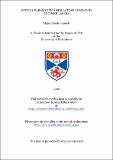Optical parametric oscillators pumped by excimer lasers
Abstract
This thesis describes the development of a new generation of pulsed optical parametric oscillators (OPO's) based on two new non-linear materials, urea and beta-BaB2O4 (or BBO), and pumped by a new class of laser pump sources, namely, excimer lasers, to provide broadly tunable coherent radiation in new regions of the electromagnetic spectrum, particularly in the ultraviolet and the visible, which have previously been inaccessible. The laser pump source used during this work was a pulsed ultraviolet XeCl excimer laser operating at 308nm. Because of the stringent demands on the pump beam quality (with regard to both spatial and spectral coherence) for successful operation of OPO's, the pump laser was designed and constructed as an injection-seeded system, to provide a narrow-linewidth, near-diffraction-limited output beam, with sufficiently high peak powers to enable OPO operation. In this way, we were able to obtain an output beam with a linewidth ≤ 0.2cm-1, and a full-angle of divergence as low as 60muR (~3 times the diffraction limit). The maximum energy available from the pump laser was 30mJ, in pulses measuring typically 10ns in duration. The output beam was also linearly polarised to better than 95%, and the pulse repetition rate was 1 Hz. In the early part of this work, we used the constructed pump laser to investigate spontaneous parametric fluorescence in a home-grown urea sample, in order to characterise the crystal, and to compare the observed spectrum with the calculated OPO tuning curves. The results of these experiments were found to be in good agreement with the theoretical predictions. The main thrust of the project, however, was the development of an OPO based on urea as the non-linear medium and pumped at 308nm by the narrowband XeCl excimer laser. We were successful in constructing such an OPO, using an 8-mm-long, home-grown crystal, and were able to generate, continuously tunable output from 572 to 667nm, with a 2.5% energy conversion efficiency. The timing range of the device was later extended to 537-720nm, by utilising a 15-mm-long, home-grown urea sample, and its conversion efficiency was improved to as high as 37% at 90° phase-matching, with ≥ 10% efficiency over a 100-nm range in the visible (from 570 to 670nm). Finally, in an effort to achieve even higher efficiencies, we performed experiments in a 25-mm-long commercial urea crystal, and demonstrated exceptionally high external energy conversion efficiencies of up to 66%, with evidence of even higher levels of pump depletion (as high as 85%) at 90° phase-matching. The latter part of the project was concerned with the design and development of a similar device based on the new non-linear material, beta-BaB2O4, to provide continuously tunable radiation over a much broader tuning range, particularly in the blue and the near ultraviolet, not accessed by the urea OPO. We used a 12-mm-long commercially available beta-BaB2O4 crystal to construct this OPO, and successfully operated this device over the entire wavelength range from 354nm in the near ultraviolet, throughout the visible, to 2.37mum in the near infrared, with an energy conversion efficiency in excess of 10% over the range 450-960 nm. The constructed OPO's were also characterised with regard to several operating parameters, including oscillation threshold, spectral linewidth, as well as spatial and temporal variation and, where appropriate, the experimental results were compared with the predictions of theory.
Type
Thesis, PhD Doctor of Philosophy
Collections
Items in the St Andrews Research Repository are protected by copyright, with all rights reserved, unless otherwise indicated.

